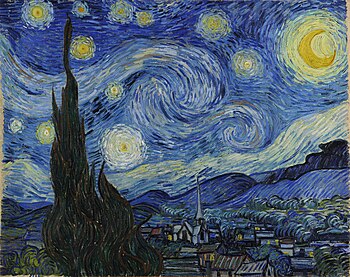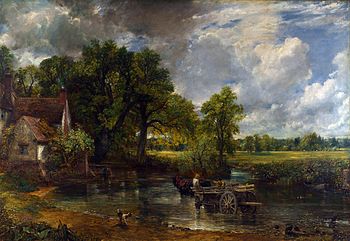Since centuries, landscape painting has captured the beauty of nature and the grandness of the environment. It also captures the interaction between people and their surroundings. Famous landscape artists have created works that serve as a window to the world, capturing everything from serene pastoral scenes and dramatic seascapes to surreal interpretations. We explore 20 of the most iconic landscapes in the world, each one a masterpiece.
1. Vincent van Gogh's "Starry Night", 1889

Image Courtesy: https://en.wikipedia.org/wiki/The_Starry_Night
Vincent van Gogh’s "Starry Night", arguably the most famous painting in the world, is one of the best-known. Van Gogh painted this masterpiece from his asylum window, which shows a night sky swirling over a village. Van Gogh’s vibrant colors and dynamic brushstrokes evoke a sense emotional turmoil and cosmic wonder.
2. John Constable, "The Hay Wain", 1821

Image Courtesy: https://en.wikipedia.org/wiki/The_Hay_Wain
John Constable’s The Hay Wain, a classic example of English landscape art, is one of the most famous landscape paintings in history. The painting depicts a rural scene in which a horse-drawn wagon, also known as a wain, crosses a river on the English countryside. Constable's painting shows his mastery of capturing the tranquil beauty of the English countryside and his deep respect for nature.
3. "The Persistence Of Memory" by Salvador Dali, 1931

Image Courtesy: https://en.wikipedia.org/wiki/The_Persistence_of_Memory
The surrealistic interpretation of space and time in "The Persistence of Memory", by Salvador Dali, is a striking feature of the painting. The painting depicts melting clocks draped across a desolate terrain, challenging conventional views of time and reality. It offers a unique blend between the natural and metaphysical.
4. Water Lilies by Claude Monet, 1896-1926

Image Courtesy: https://en.wikipedia.org/wiki/Water_Lilies_(Monet_series)
Claude Monet’s "Water Lilies Series" is one of the most celebrated works in Impressionist art. Monet's "Water Lilies" series captures the tranquility of the garden pond and its floating lilies. The interplay of color, light, and reflection is highlighted. Each of the paintings in this series shows a different view of the same subject. This demonstrates Monet's commitment to exploring the subtleties of natural beauty.
5. Raphael's "The School of Athens", 1509-1511

Image Courtesy: https://en.wikipedia.org/wiki/The_School_of_Athens
Raphael’s "The School of Athens", while not strictly a landscape, features a grand architecture backdrop that reflects Renaissance ideas of learning and humanism. The harmonious composition and intricate perspective of the painting are a testament to Renaissance reverence for classical learning and the natural environment.
6. Katsushika Hokusai's (1831) "Mount Fuji Seen Under the Falls at the Base Of Kurokami"

Katsushika's Hokusai woodblock print, "Thirty-Six Views of Mount Fuji", is a breathtaking representation of Mount Fuji set against a dramatic background of cascading falls. This print is known for its dynamic composition, which combines the majestic majesty Mount Fuji with powerful natural forces.
7. "The Night Watch" by Rembrandt van Rijn (1642)

Image Courtesy: https://en.wikipedia.org/wiki/The_Night_Watch
The Night Watch by Rembrandt is a powerful portrayal of an action-oriented city guard, against a background of light and shade. The painting is primarily a portrait of a figure, but its dramatic use and atmosphere in the busy city are what make it so important.
8. The Great Wave Off Kanagawa by Katsushika Hokusai, 1831

Image Courtesy: https://en.wikipedia.org/wiki/The_Great_Wave_off_Kanagawa
The Great Wave Off Kanagawa, another masterpiece by Hokusai is one of the world's most influential and famous prints. This print shows a huge wave towering above boats near Mount Fuji. It captures the raw power and beauty of nature through bold lines. This print is a great example of how Japanese landscape art influenced Western perceptions.
9. Sandro Botticelli, "The Birth of Venus", circa 1485-1486

Image Courtesy: https://www.uffizi.it/en/artworks/birth-of-venus
Sandro Botticelli’s The Birth of Venus, a seascape with mythological content, is a masterpiece and one of the most beautiful landscape paintings. The goddess Venus is depicted emerging from the ocean, surrounded by a beautiful and idealized seascape. This painting exemplifies Renaissance beauty ideals and the harmonious relationship of humans with nature.
10. Vincent van Gogh, "The Red Vineyard", 1888

Image Courtesy: https://en.wikipedia.org/wiki/The_Red_Vineyard
Vincent van Gogh’s "The Red Vineyard", is noteworthy for being the one painting Van Gogh ever sold. Van Gogh depicts an autumnal vineyard in vibrant colors and dynamic brushstrokes. The painting captures the beauty of rural living and Van Gogh’s passion for his subject.
11. Wassily Kandinsky, "Composition VIII", 1923

Image Courtesy: https://www.britannica.com/topic/Composition-VIII
Wassily Kandinsky’s "Composition VIII", a stunning example of abstract landscape paintings, is an impressive piece. Kandinsky's "Composition VIII" is a striking example of abstract landscape painting.
12. El Greco's "View of Toledo", 1596-1597

Image Courtesy: https://en.wikipedia.org/wiki/View_of_Toledo
El Greco’s "View of Toledo", a dramatic, expressive depiction of the Spanish capital. El Greco’s "View of Toledo" features a turbulent sky and a vast landscape. It reflects his unique style, and his ability infuse landscapes with spirituality and an otherworldly quality.
13. "The Harvesters", by Pieter Bruegel, the Elder (1565)

Image Courtesy: https://en.wikipedia.org/wiki/The_Harvesters_(painting)
Pieter Bruegel's "The Harvesters", a vivid depiction of rural life in the 16th Century, is a powerful portrayal. The busy harvest season is captured in this painting, which includes detailed depictions of landscapes and figures. It provides a rich, immersive view of rural life.
14. "Sunrise", by Claude Monet, 1872

Image Courtesy: https://en.wikipedia.org/wiki/Impression,_Sunrise
The "Sunrise", a painting by Monet, is what gave the Impressionists their name. Soft brushstrokes, vibrant colors and soft tones capture the beauty of dawn. Monet's unique approach to capturing light and atmosphere was a departure from the traditional landscape paintings.
15. Hieronymus Bosch, "The Last Judgment", c. 1482

Image Courtesy: https://en.wikipedia.org/wiki/Impression,_Sunrise
Hieronymus' "The Last Judgment", a religious work, features imaginative and elaborate landscapes depicting the worlds of hell and heaven. The painting's deep impact is a result of the intricate landscapes and symbols.
16. The Fighting Temeraire by J.M.W. Turner (1839)

Image Courtesy: https://en.wikipedia.org/wiki/The_Fighting_Temeraire
J.M.W. Turner's "The Fighting Temeraire", a moving portrayal of an historic British ship on its last voyage, is a powerful work. The painting is praised for its masterful use and atmospheric effects that capture both the majestic presence and transient beauty in the natural world.
17. Edvard munch's "The Scream", 1893

Image Courtesy: https://www.edvardmunch.org/the-scream.jsp
Edvard Much's "The Scream", an expressionist masterpiece, is a work of iconic importance. It features a swirling and dramatic landscape, which adds to the overall feeling of existential anxiety. The powerful colors and bold brushstrokes of the painting amplify the emotional impact.
18. Winslow Homer's "The Gulf Stream", 1899

Image Courtesy: https://en.wikipedia.org/wiki/The_Gulf_Stream_(painting)
Winslow Homer’s "The Gulf Stream", depicts a lone sailor adrift in a turbulent ocean, demonstrating Homer's ability to capture nature's unpredictable and raw force. The dramatic composition of the painting and the realistic portrayal of the sea highlight the isolation and challenges of maritime life.
19. Johannes Vermeer, "A View of Delft", ca. 1660

Image Courtesy: https://en.wikipedia.org/wiki/View_of_Delft
Johannes Vermeer’s "A View of Delft", a calm and meticulously detailed depiction of the Dutch town of Delft, is a peaceful and serene portrayal. This painting is praised for its exquisite use of light, and the precise portrayal of architectural and natural features. It reflects Vermeer’s exceptional ability to capture everyday beauty.
20. "The Bridge at Argenteuil", by Claude Monet, 1874

Image Courtesy: https://en.wikipedia.org/wiki/View_of_Delft
Monet's "The Bridge at Argenteuil", a painting of the Seine River, depicts a scene with a bridge as well as boats. It captures the essence of French Impressionism. Monet was fascinated by capturing fleeting moments of nature. The vibrant colors and lively brushes in the painting convey a feeling of light and movement.
The 20 landscape paintings in this collection represent some of most important contributions to the genre. Each painting offers a unique perspective on nature and the human experience. These masterpieces, from Van Gogh's "Starry Night", to Monet's "Water Lilies" with its serene reflections, continue to inspire and capture audiences all over the world. Each painting celebrates in its own unique way the beauty, complexity and diversity of landscapes. It invites viewers to explore the globe through the eyes of the greatest artists of all time.









